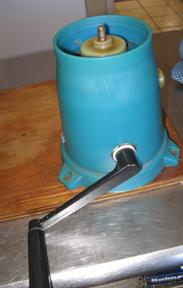Big smoking day today. I have about 40 lbs of pork to smoke; about
half of it hot smoked (2 shanks, 4
cappocolo, some spare ribs and a few chops) and half cold smoked (6 slabs of
belly and 2 jowls for bacon, and another
few chops)
My hot/cold smoker set-up is a combo
hybrid. The hot box is fairly stock
propane unit, off-the-shelf with the exception of the converted smoke
stack. The cold box is home-built from a
35-gallon galvanized trash can, some stove pipe parts (chimney), and some shelf
brackets plus a length of dryer hose and a battery-operated fan from Radio
Shack to pull the smoke from the hot box. The fan runs for a couple of days on
8 AA batteries. It is switched(side of
the battery box) but I've never cold smoked without it running so I probably
could have skipped that additional feature.
I'll be smoking with hickory today
so I get the chips soaking in the chip box.
I'll also be doing a moist smoke so
I get my pan of water on to heat. No
sense in putting cold water in the smoker and having it take that much longer
to get up to temperature. I also season
my water bath heavily with garlic, onions, hot peppers and a glug of cider
vinegar. I'm not sure if it really imparts any flavor to the meat but it sure
makes it smell great while cooking!
I drain the chips after about 15
minutes and put them and the water pan in the smoker, fire it up and crank the
heat to "high" to pre-heat while I get the meat ready.
Yesterday I pulled all the meats
from their respective brines/smears and set them on sheet pans in the fridge to
air-dry for about 24 hours.
Additionally, I tied all the cappos roast-style to help them hold a nice
tight shape while smoking and really packed the outsides with my spicy cappo seasoning
(See this post for details) That just
left setting the pieces up for hanging today.
I poked holes in a corner of each belly piece, using a butcher's steel,
threaded some heavy cotton twine through and knotted a small loop. I usually use paper clips for my hooks,
simply hooking them through the twine and then hanging them on the smoker
racks.
Time to load the hot smoker. I put the shanks, ribs, and some of the chops
on racks in the hot box, then hang the cappos below them and close up the
box. You want to keep open-door time to
a minimum on the hot box - you don't want to vent any more smoke out then
absolutely necessary plus even, constant, low temperature is the key to great
results. I've read that you have to plan on adding a hour to your smoking time
for every time you open the door. This
sounds a little extreme to me but it does emphasize the point well. I'll be
shooting to keep the temperature in the hot box just under 200 degrees F today.
With the hot box going well it's
time to fill the cold smoker. I hung the
belly pieces on a rack at the highest position, then fill the rack with the chops and jowls, flip on the fan to
start the smoke flowing from the hot smoker and snap on the lid. It's going to be a little warmer outside
today than Ideal for cold smoking (supposed to be in the low 50's) so I opened
the damper in the chimney of the cold box to help keep heat from building
up. I've got temperature probes in place
so I can track things throughout the day and I'm going to try to keep the
temperature below 100 degrees F in the cold smoker.
After 30 minutes I adjust the heat
down a little in the hot box. Once they
equalize, both boxes are sitting right at their design temperatures and they
stay there the rest of the day without further adjustment.
6 hours later, the meat is
done! The internal temperature of the
biggest pieces are above 160 degrees F in the hot box and all of the pieces in
the cold box look and smell perfect.
It's time to unload the smokers.
I put all the pieces on lined sheet
pans and pop them in the cooler right away to start chilling overnight. The next thing for most of them will be slicing
packaging, and freezing. Oh yeah - and eating!
 |
| Cold smoked bellies (bacon) |
 |
| Hot smoked chop |
 |
| Cappo |
 |
| Shank |
 |
| Spare ribs |















































